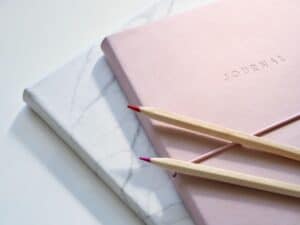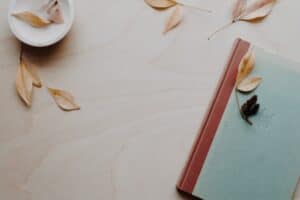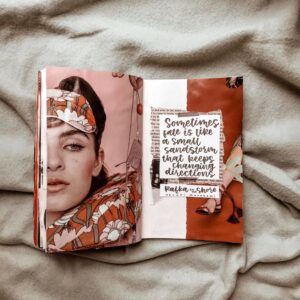
Are you new to keeping a journal or want a fresh start? This post lists 3 journal styles so you can explore the best journal type for your unique personality.
First, a little background: I fell in love with poetry when I was 6. I nabbed a dog-eared paperback of Pablo Neruda’s Residence on Earth from my parents’ bookshelf. I carried it around and read poetry out loud to myself and our pets!
Once I decided I wanted in on the poetry writing-action, I filled page upon page in black hardbound sketchbooks. Hardbound, unlined books became my go-to for the next 2 decades.
Even now, I still prefer a hardbound journal to jot down my reflections and feelings every evening.
Since you are unique, find what satisfies you.
Want some journal ideas? Check out the 3 journal styles below.
1. Structured Journals
Do you like structure? Here are some ideas to create structure for your journal practice:
Alternatively, another easy-to-do idea is to create your own structure. For example, spend a week writing about color—where did you notice the color blue? Or focus on your senses; describe sounds that you notice and use that to launch into thoughts about those sounds and what they remind you of.
Any type of journal book will work, but since you like structure, try lined or dot-lined books. A journal with pre-made templates and prompts will be easiest to get started, but with a little extra effort you can DIY a structured journal.

2. Freewrite Journals
Why choose freewriting as your journal style? First and foremost, freewriting is easy to do. You can use any type of notebook or journal, lined or unlined, depending on your preference. Choose a free-flowing pen to keep your writing moving along quickly.
Undoubtedly, the classic writing companion Writing Down the Bones by Natalie Goldberg is a great starting point to get the hang of freewriting.
Above all, the idea is to get your thoughts down on paper quickly and without judgment. For this reason, freewriting allows you to tap into your subconscious mind to bring up experiences your brain had filed away. Goldberg recommends the cheap spiral notebooks kids buy when it’s back-to-school time.
To start freewriting, follow these steps:
Goldberg adds: “Don’t worry about making sense. Don’t worry about being perfect.” If you get stuck you can simply repeat “I don’t know what to write” or another repeated phrase until you get unstuck.
Freewriting is great if you want to break free of limitations. To find your unique voice, this method is the best!

3. Visual Journals
A third journal type is the visual journal. If you like to express yourself with images, or you are drawn toward other people’s visual journals, this option is for you!
First, find a journal with heavy enough pages to support glued images of different weights. The paper should be thick enough that the ink or other materials you want to use won’t leak through.
Generally, I like watercolor journals or notebooks with smooth paper (“hot-pressed”). Any paper that takes watercolor or mixed media will stand up to anything you want to glue or paint onto the pages.
Next, follow these steps to get started with your visual journal:
In sum, there are lots of ways to add visuals to your journal pages. You can simply grab some markers or watercolor to lay down some color, and then glue images on top.
We’ll explore more options in a future blog post.
Your Unique Journal Style
In future posts, I’ll share exercises and techniques to expand and adapt your chosen journal. Your future journal will be as structured, free-flowing, or visual as you like. How exciting! Your own space to experiment, express, and be yourself.
Want to explore journals to purchase? Visit the Resources page for ideas.
You’ll find more tips and techniques from Small Steps, Big Joy in future posts. Have fun tailoring your journal to your unique interests!